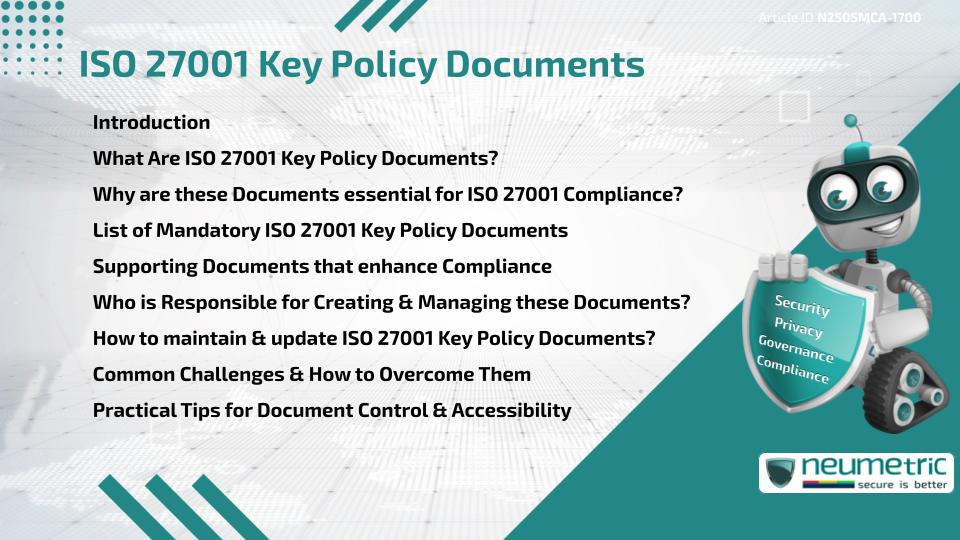Table of Contents
ToggleIntroduction
For Organisations working toward Compliance with the ISO 27001 Standard, Documentation plays a central role. These Documents are not just Checkboxes for Audits—they shape how Information Security is designed, implemented & sustained.
Understanding the ISO 27001 Key Policy Documents helps Businesses build a compliant & practical Information Security Management System [ISMS]. This article explores these essential Documents, why they matter & how they help ensure long-term Data Protection & Operational Stability.
What Are ISO 27001 Key Policy Documents?
A globally recognised standard for managing Information Security is ISO 27001. The Key Policy Documents under this Framework serve as formal Records of Intent, Procedures & Responsibilities. They guide everyday security operations & demonstrate Compliance during Internal & External Audits.
These documents fall under three (3) broad categories:
- Mandatory Documents: Required for Certification.
- Supporting Documents: Enhance Clarity & Management.
- Records & Logs: Serve as Evidence of Implementation.
Think of these Documents as a Blueprint for how an organisation protects its Data. Without them, efforts remain unstructured & unverifiable.
Why are these Documents essential for ISO 27001 Compliance?
ISO 27001 Key Policy Documents are critical because they:
- Show that an organisation understands & manages Information Security Risks.
- These Documents support the implementation of the Security Controls listed in Annex A.
- Provide a foundation for Internal Audits & Continuous Improvement.
- Help demonstrate Regulatory & Contractual Compliance.
They also offer Continuity. If Leadership or Staff changes, these Documents maintain consistency in security efforts.
For more on the importance of Documentation, the International Organisation for Standardisation explains the structure & goals of ISO 27001.
List of Mandatory ISO 27001 Key Policy Documents
Below are the mandatory documents required by ISO 27001:
- Information Security Policy
Sets out the overall direction & principles of the ISMS. - Risk Assessment & Risk Treatment Methodology
Defines how Risks are identified, evaluated & mitigated. - Statement of Applicability [SoA]
Lists the Security Controls chosen from Annex A & justifies Inclusions or Exclusions. - Risk Treatment Plan
Describes specific steps for addressing Identified Risks. - Access Control Policy
Specifies who can access information & how rights are managed. - Operating Procedures for IT Management
Documents routines & Guidelines for secure IT Operations. - Incident Management Procedure
Provides steps to report & respond to Security Events. - Internal Audit Program
Outlines how & when Internal Audits are performed. - Corrective Action Procedure
Defines how to deal with Nonconformities & prevent Recurrence. - Record of Training & Competence
Tracks who has been trained & on what topics.
Each Document must be reviewed regularly & approved by Management.
Supporting Documents that enhance Compliance
While not mandatory, Supporting Documents strengthen your ISMS. Common examples include:
- Mobile Device Policy
- Supplier Security Policy
- Remote Work Policy
- Data Classification Guidelines
- Password Management Procedure
These Documents help organisations customise Security Practices to real-world situations. For instance, a Remote Work Security Guide by the UK’s NCSC shows why these policies matter more than ever.
Who is Responsible for Creating & Managing these Documents?
Typically, responsibility lies with the Information Security Officer or Compliance Manager. However, collaboration is key. Technical Leads, HR & Operations Teams contribute to specific Documents.
Final Approval usually rests with Senior Management, ensuring alignment with Business Goals.
How to maintain & update ISO 27001 Key Policy Documents?
A well-maintained Documentation System is essential for Compliance. Documents should:
- Be Version-controlled.
- Include Change Logs.
- Be reviewed at defined intervals.
- Be accessible only to Authorised Personnel.
Tools like Document Management Systems & shared Secure Repositories can simplify this process. Regular Audits help identify outdated or missing content.
Common Challenges & How to Overcome Them
Lack of Clarity
Policies are often written in overly complex language. Solution: use plain English & keep it relevant to Users.
Inconsistency
Documents created by different Departments may not align. Solution: use Templates & centralised Editing.
Poor Access Control
Policies are sometimes shared too widely or not at all. Solution: assign clear Access Roles & apply Encryption if needed.
Practical Tips for Document Control & Accessibility
- Assign a Document Owner for each file.
- Set reminders for Regular Reviews.
- Use Metadata to categorise & find Documents easily.
- Train Staff to understand where to find & how to use Policies.
Ease of Access must never come at the cost of security. Balance is key.
Limitations & Criticisms of the Documentation Approach
Although Documentation is vital, critics argue that:
- Too much focus on Paperwork can dilute focus from actual implementation.
- Some Small Organisations find maintaining all Documents burdensome.
- Over-documentation can cause delays in Decision-Making.
When applied thoughtfully, the benefits significantly outweigh the drawbacks.
Takeaways
- ISO 27001 Key Policy Documents are central to any effective ISMS.
- Mandatory & Supporting Documents work together to ensure Compliance & Consistency.
- Maintenance, clarity & accessibility are crucial.
- Smart Documentation supports both Certification & day-to-day Security.
FAQ
What is the minimum number of ISO 27001 Key Policy Documents required?
At least ten (10) documents are mandatory for Certification, though more may be needed based on your Business Scope.
Who approves the ISO 27001 Key Policy Documents in a Company?
Senior Management typically reviews & approves these Documents to ensure alignment with strategic goals.
How often should ISO 27001 Key Policy Documents be updated?
They should be reviewed annually or when significant changes occur in your Organisation or Risk landscape.
Can we use Templates for ISO 27001 Key Policy Documents?
Yes, Templates are useful starting points but must be customised to fit your Organisation’s Context & Risks.
What happens if some ISO 27001 Key Policy Documents are missing?
Missing Documents can result in Audit Nonconformities & may prevent Certification.
Are ISO 27001 Key Policy Documents the same for all Companies?
No, they must reflect the specific Risks, Processes & Systems of each organisation.
Do Small Businesses also need all ISO 27001 Key Policy Documents?
Yes, but they can scale the depth & complexity based on their size & scope.
Need help?
Neumetric provides organisations the necessary help to achieve their Cybersecurity, Compliance, Governance, Privacy, Certifications & Pentesting goals.
Organisations & Businesses, specifically those which provide SaaS & AI Solutions, usually need a Cybersecurity Partner for meeting & maintaining the ongoing Security & Privacy needs & requirements of their Clients & Customers.
SOC 2, ISO 27001, ISO 42001, NIST, HIPAA, HECVAT, EU GDPR are some of the Frameworks that are served by Fusion – a centralised, automated, AI-enabled SaaS Solution created & managed by Neumetric.
Reach out to us!


